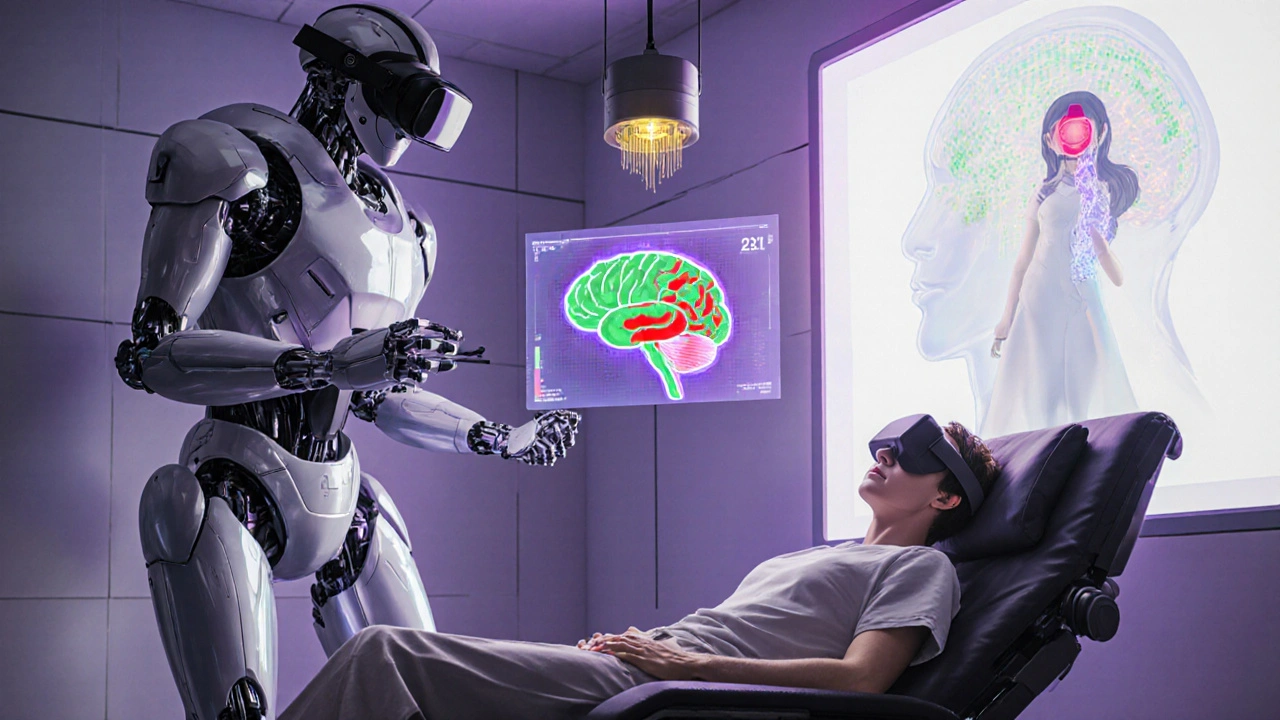OCD Treatment Response Calculator
How this tool works
This calculator estimates your potential response rate to different OCD treatments based on current research. The data comes from clinical studies referenced in the article. Your results are for informational purposes only and should not replace professional medical advice.
When you hear the words Obsessive-Compulsive Disorder (OCD) is a chronic mental health condition marked by intrusive thoughts and repetitive behaviors, you probably think of therapy sessions and medication. The good news is that OCD research is sprinting forward, and the next decade could bring tools that feel more like science‑fiction than yesterday’s clinic. Below is a plain‑talk guide to the biggest trends that may reshape how we understand and treat OCD.
Key Takeaways
- Neuroimaging and genetics are pinpointing new brain circuits linked to OCD.
- Brain‑stimulation methods such as DBS and TMS are moving from experimental to mainstream.
- AI‑driven diagnostic platforms promise faster, more personalized assessments.
- Virtual‑reality exposure and glutamate‑targeting meds are expanding the treatment toolbox.
- Hybrid care models that blend classic CBT/ERP with tech will likely become the new standard.
What’s New in OCD Science?
Over the past five years, two research fronts have exploded.
Neuroimaging is the use of MRI, PET and functional scans to map brain activity in real time. Large‑scale studies now show that the cortico‑striato‑thalamo‑cortical loop, especially the anterior cingulate cortex, lights up differently in people with OCD compared with controls. This isn’t just academic-knowing the exact circuitry helps surgeons place electrodes for stimulation and guides psychologists toward more targeted exposure tasks.
On the genetics side, genome‑wide association studies (GWAS) have identified more than a dozen risk loci, many of which involve the glutamate system. A 2024 paper from the International OCD Genetics Consortium linked the SLC1A1 gene to compulsive checking behaviors. Such findings are nudging drug developers toward glutamate modulators, which we’ll discuss shortly.
Another surprising player is the gut‑brain axis. Researchers at the University of Cambridge reported that a specific gut‑microbiome profile correlates with severity scores on the Yale‑Brown Obsessive Compulsive Scale (Y‑BOCS). While it’s early days, probiotic trials are already on the docket.
Emerging Treatment Modalities
Traditional care still starts with Cognitive Behavioral Therapy (CBT) - a structured, evidence‑based talk therapy, most often delivered as Exposure and Response Prevention (ERP) - the systematic confrontation of feared thoughts while resisting the ritual. Yet, many patients either can’t access skilled therapists or don’t respond fully. New tools are filling those gaps.
Deep Brain Stimulation (DBS) is a surgical technique that delivers continuous electrical pulses to targeted brain regions. In a multicenter 2023 trial, 68% of severely treatment‑resistant OCD patients reported a ≥35% drop in Y‑BOCS scores after twelve months of DBS to the ventral capsule/ventral striatum. The biggest hurdle remains the invasiveness, but advances in imaging and programmable hardware are lowering risks.
Transcranial Magnetic Stimulation (TMS) offers a non‑invasive alternative. A double‑blind study in 2024 showed that high‑frequency TMS over the dorsolateral prefrontal cortex reduced compulsive symptoms in 45% of participants versus 20% in the sham group. Sessions are quick, outpatient‑friendly, and now covered by more national health systems.
Pharmacologically, the spotlight is shifting from selective serotonin reuptake inhibitors (SSRIs) to Glutamate Modulators such as memantine and riluzole. A 2025 meta‑analysis found that adding a glutamate blocker to an SSRI regimen improved response rates by roughly 15%.
Virtual reality (VR) is also stepping onto the stage. By simulating feared environments-like a cluttered kitchen for contamination OCD-VR lets patients practice ERP from home. Early trials report comparable outcomes to in‑person exposure with the added benefit of precise control over stimulus intensity.

Personalized Medicine and AI
Artificial intelligence is moving from research papers to clinic desks. Machine‑learning models trained on neuroimaging, genetic, and behavioral data can predict which patients are likely to benefit from DBS versus TMS with about 80% accuracy. While still a decision‑support tool, such AI platforms help clinicians avoid the trial‑and‑error approach that has long plagued OCD treatment.
Precision medicine also means tailoring medication based on a patient’s genetic makeup. For someone carrying the SLC1A1 risk allele, a clinician might consider an early trial of a glutamate modulator rather than waiting for SSRI failure.
Integrating Old and New: A Hybrid Care Model
Imagine a treatment plan that starts with a brief ERP course, supplements progress with weekly TMS, and uses a VR app for daily practice between sessions. Data from the VR app syncs to a cloud dashboard that feeds an AI algorithm, flagging moments of increased anxiety for the therapist to address in the next appointment. This kind of blended approach is already pilot‑tested in several university hospitals across Europe and the U.S.
Key benefits include:
- Reduced reliance on high‑dose medication.
- More flexible scheduling for patients who juggle work and family.
- Objective metrics (e.g., brain activation patterns) that guide treatment tweaks.

Practical Checklist for Patients and Clinicians
- Ask your therapist if they incorporate digital ERP tools or VR modules.
- If you’ve tried at least two SSRIs without success, discuss brain‑stimulation options.
- Consider a genetic test if you have a strong family history of OCD or related neuropsychiatric conditions.
- Stay updated on AI‑driven diagnostic services-many are now offered through tele‑psychiatry platforms.
- Track symptom changes with a standardized scale (Y‑BOCS) every 4‑6 weeks to gauge treatment impact.
Traditional vs. Emerging Treatments
| Aspect | Traditional (CBT/ERP + SSRIs) | Emerging (DBS, TMS, VR, AI) |
|---|---|---|
| Invasiveness | Non‑invasive | DBS is invasive; TMS, VR, AI are non‑invasive |
| Response Rate (≥35% Y‑BOCS reduction) | ~50% with combined CBT + SSRI | DBS 68%; TMS 45%; VR‑augmented ERP 55% |
| Time to Benefit | Weeks to months | DBS: months; TMS: 4‑6 weeks; VR: immediate practice boost |
| Side‑Effect Profile | SSRI weight gain, sexual dysfunction | DBS surgical risks; TMS mild headache; VR motion sickness rare |
| Access / Cost | Widely available, low‑moderate cost | DBS high cost; TMS moderate; VR apps inexpensive; AI platforms subscription‑based |
Frequently Asked Questions
Can I try TMS before considering surgery?
Yes. Most clinics offer a trial course of TMS, and guidelines recommend exhausting non‑invasive options before moving to DBS.
Is VR exposure therapy covered by insurance?
Coverage varies by country and provider. In the UK, some NHS trusts are piloting VR as part of mental‑health pathways, but private insurers may treat it as an out‑of‑pocket service.
How reliable are AI diagnostic tools for OCD?
Current AI models are decision‑support aids, not definitive diagnoses. They help flag high‑risk patterns but still require a clinician’s confirmation.
What genetic tests are useful for OCD?
A panel that includes SLC1A1, HTTLPR, and glutamate‑related genes can provide insight, especially for treatment‑resistant cases. Discuss with a genetic counselor before ordering.
Are glutamate modulators safe long‑term?
Short‑term studies show a favorable safety profile, but long‑term data are still limited. Monitoring liver function and renal markers is recommended.
